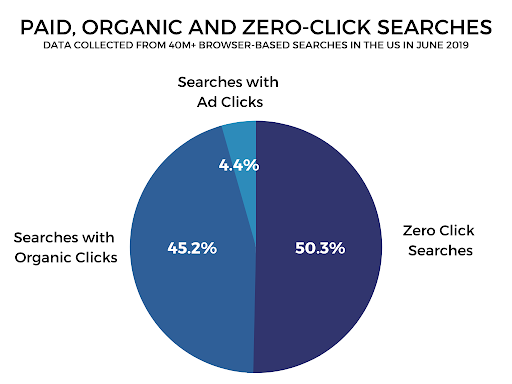When compared to what it looked like only a few years ago, Google's SERP (search engine results pages) has undergone significant transformations, rendering it practically unrecognisable. These changes extend beyond surface-level alterations and involve elements like search engine optimization (SEO) techniques and the integration of Google Analytics.
During her keynote address at SMX Advanced, Jessica Bowman, editor for Search Engine Land and CEO of SEO In-House discussed these changes and how SEO Strategy from search to purchase is being profoundly altered by the evolution.
Check out the following blogs for more information:
- How to Quantify SEO ROI: The Best 2023 Guide
- The Dos and Don'ts of B2B SEO: Best Practices for Success
- The Ultimate Guide to B2B SEO: Boost Your Online Presence
- The definitive guide to SEO by Incisive Edge
Google also controls the process by allowing consumers to acquire information, take action, and even transact without having to navigate to a website.
This will have an impact on almost every company with a web presence. Bowman provided numerous action plans for SEOs preparing for these developments, stating that SEO investments will be more vital than ever - but we’ll get into that later.
Going back to 2010, Moz founder Rand Fishkin actually predicted that something like this would happen. His prediction was that Google searches would bring fewer and fewer visitors. Sure enough, Google delivered, offering highlighted snippets in the middle of the decade.
Featured snippets have ushered in the era of “zero click” searches, which occur when Google answers your query without directing you to another page.
Google quickly followed with more of the same, such as response boxes and predictive replies in the drop-down bar - if you Google the weather, you don't even have to press enter to obtain your answer. This means that, from about June 2019, most Google searches are now “zero click” searches.

According to Guy Sheetrit, CEO of Over the Top SEO, we're now moving into a new era of SEO. He predicts that one of the things we'll begin to see is that Google's understanding of language will skyrocket, impacting various aspects such as search intent, on-page SEO, and even the optimization of every blog post one produces.
Especially from an e-commerce standpoint, so now is the time to reorganise and ensure that your SEO strategy is ready for the future age.
But what does it mean when we say Google is shifting from search engine to portal?
According to Guy Sheetrit, CEO of Over the Top SEO, we’re now moving into a new era of SEO. He predicts that one of the things we’ll begin to see is that Google’s understanding of language will skyrocket.
Especially from an e-commerce standpoint, so now is the time to reorganise and ensure that your SEO strategy is ready for the future age.
But what does it mean when we say Google is shifting from search engine to portal?
Google Shifts from Search Engine to Portal
The most important question to ask now is, what is a portal? Anything that acts as a shared platform via the internet and often provides several links to a diverse range of data, information, resources, and services. Sounds familiar, doesn’t it?
Google is basically this - the same thing that functions as a gateway search engine. As you may have observed, Google urges users to register an account before they begin browsing. It collects a massive quantity of data about each individual user in this manner.
But what is the benefit? Well, the user gets a more personalised experience and Google receives all the information it needs to make the user feel comfortable on its platform - and to sell to them most effectively.
Google and SEO are inextricably linked. Why? Structured data markup is another approach used by Google to arrange web pages in its portal. Essentially, this is a method for websites to communicate with Google about the amount of product pages they have, which pages correspond to which set of categories, and other information. This communication helps Google understand the content better, leading to improved search volume, technical SEO, and organic search visibility for websites utilising structured data markup.
Google, or the SEO portal, swiftly grasps all of that information and its algorithm determines what to present in the search results for each search query.
How to Adapt Your SEO Strategy to Deal With These Changes
There are a few things that you can do to adapt your SEO strategy to ensure you're ready for the new era of SEO.
Understand Where SEO Fits in With Your Overall Goals
Neither SEO nor marketing of any kind is an end unto itself. Your company should have specific goals, preferably measurable, time-bound and attainable. Your marketing goals should support these overall goals, and your SEO should support your marketing goals.
There's no point in adapting your search engine optimization strategy, or even having an SEO strategy at all, if you don't have clear and defined goals. These goals should encompass not only improved organic traffic and search engine rankings but also the effective utilization of every SEO tool and monitoring of SEO metrics. By setting specific objectives, you can align your efforts towards achieving measurable results in terms of organic traffic growth and optimizing key SEO metrics.
This takes considerable forethought. Loading up your blog with keywords haphazardly will not yield results. It will, however, take time for you to create material that may or may not generate traffic and outcomes.
So, for the coming decade, play the long game. Integrate your SEO efforts into your overall marketing goals and company objectives. Consequently, work across departments will be more harmonic and strategic.
Make Sure Your Site is Structured For Easy Navigation With Breadcrumbs
Breadcrumbs are the trail that allows people to return to your site one click at a time. It immediately outlines your website’s cascading hierarchy for Google as well. If you make it simple for Google to comprehend the structure of your site, they will prefer it and it will appear higher in customer Google searches.
Breadcrumbs, like other excellent SEO components, serve the dual purpose of making your site simpler for both customers and search engines. Are you doing it for the benefit of the customer? Or are you doing it to appease the algorithm? The truth is that they both help each other.
Shift To Long Tail Keywords Rather Than Competing for The Most Popular Ones
Give yourself a breather and try a fresh keyword research strategy if you've been battling with keyword fights you can't win. Of course, if you sell shoes, you want to be found when people search for “shoes.” But that may or may not be realistic and it may or may not matter. It's likely that the amount of money and effort required to rank for that one hot term would be better spent elsewhere.
Long tail keywords are less competitive, so go for those. For example, having the sole e-commerce site that ranks for a long tail keyword such as “black leather ankle boots with buckle” may be more profitable than ranking for “boots” or even “women's shoes” in some cases.
Looking through Google’s predictive text is a wonderful place to start if you're not sure how to come up with long tail keywords. Just type your keyword into the Google search bar and see what results autofill. These are probably the keywords you should aim to rank for. Or make use of a tool like Answer the Public.

Image Source: AnswerThePublic
As Google becomes smarter and voice search becomes more common, search queries become more conversational, implying that long tail terms are becoming more prevalent.
Customers that input long-tail, specific keywords are frequently extremely motivated and eager to make a purchase. Consider this: these customers are looking for something really specific, generally because they need it for a specific reason.
As a result, conversion rates for long-tail keywords are greater than for head keywords. Ranking for these kinds of keywords is more feasible, and you'll end up with a better conversion rate because long tail keyword searchers are generally eager to buy.
But here's the catch: Long tail keywords do not produce zero click results. This is due to the fact that individuals who search detailed terms regarding your product usually have high intent. They're on the lookout for your stuff.
Nobody knows what mischief Google will get up to in the coming decade.
However, building a proper SEO foundation with good site structure, navigable breadcrumbs, and content containing valuable long tail keywords, all nested within a larger marketing context and company goals, will position you for success when new algorithm updates and technological developments arrive.
Regardless of what they are. In the meanwhile, you won't be spending time fighting for no-click searches.








